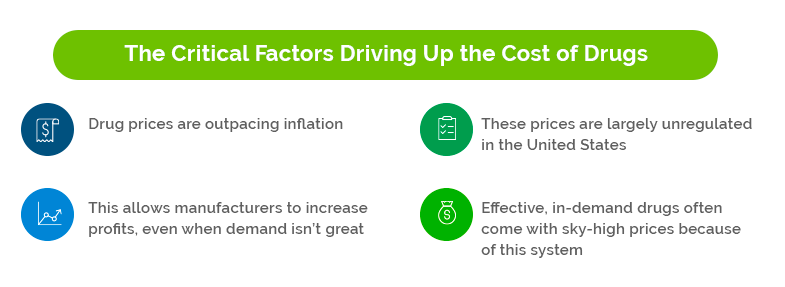
Prescription drug prices are rising more exorbitantly than the rate of inflation. Here are the culprits behind the rising costs of prescription medication.
The price of prescription meds in the U.S. has risen dramatically over the past couple of years. This has little to do with inflation rates, though, as the increase in drug prices has far exceeded average over the years. By 2024, the global sales of prescription meds are expected to hit $1.18 trillion.
The exponential returns will have less to do with increased demand for drugs and more with patients having to pay more for their medications. Learn the key factors pushing the cost of prescription meds through the roof and how you can pay less for more.
2009 GAO report
According to the 2009 Government Accountability Office (GAO) report , 416 brand-name drugs displayed “extraordinary” price increases between 2004–2008, which ranged between 100 and 499%. In exceptional cases, especially drugs used to treat fungal and viral infections or heart disease, the price increase exceeded 1000%.
For example, the cost of treating a rare form of cancer increased from $390 to $3,000. The report indicated that yearly price increases of top-brand drugs were consistently higher than the overall consumer price index increase.
It’s an unfortunate truth that drug inflation has outpaced the standard inflation rates and is likely to continue doing so unless some precipitating factors are nipped in the bud. Drug companies are free to set drug prices as they wish. They are only “accountable” to market forces – AKA, competition from other drug manufacturers – lack of demand for the drug notwithstanding. When this happens, the patients must bear the brunt of the high cost of medications.
Brands versus generics
Understanding brands versus generics lays the foundation for understanding how drug pricing works . When a new drug is introduced to the market, the company that introduced it enjoys exclusive inventor rights for a given period, during which other drug companies are not allowed to manufacture the same drug. Patent laws protect brand drugs during this period, so the original manufacturers are able to recoup their expenditures and make a profit.
After the exclusive period expires, other drug companies can introduce generics to the market. All generic drugs must have similar qualities compared to branded drugs in terms of dosage, safety, potency, performance characteristics, and intended use and must be approved by the FDA. Generics are usually priced slightly higher than the marginal cost of production, which should ideally force the original drug manufacturers to reduce the price of branded drugs to make them more competitive. Unfortunately, this rarely happens, and the following section gives 5 reasons for this.
The 5 factors influencing drug affordability
The pricing and affordability of prescription meds in the U.S. are influenced by myriad complex and highly interactive factors . These factors ultimately increase the earnings of drug manufacturers and keep some drugs out of the reach of the everyday patient. They can, however, be addressed through the participation of the government, pharmaceutical companies, healthcare institutions, and other relevant stakeholders.
High launch prices of brand drugs
When brand drugs are first introduced to the market, the manufacturers are at liberty to set the launch price. This price sets the pace for future drug prices, including generic versions. Unfortunately, these prices can often be set at exorbitant, unaffordable rates.
Slow introduction of generics to the market
Generics should be introduced to the market once the exclusivity period for branded drugs expires, which should mean a significant price reduction for the medication. When generics are not introduced promptly, the cost of brand drugs may continue to soar.
In the U.S., currently, 90% of prescriptions are filled with generics. But inadequate competition from generics means that the anticipated price drop is not always achieved.
Poor regulation of drug prices
The U.S. patent law and health insurance systems are different from those in most developed nations because it does not have the ability to regulate drug prices. This means that the government cannot control the cost of prescription drugs charged by drug manufacturers, and the pricing of medication in the U.S. has been described as “what the market will bear.” In addition, the patient assistance programs and insurance schemes that should be negotiating the price of drugs have failed.
High costs incurred for research and drug development
Genomics and precision medicine are driving up the costs of drug research and development. Drug manufacturers eventually pass these costs to the patient. In addition, drug manufacturers are more inclined to develop drugs that are likely to fetch good returns once they have been introduced to the market. Increased spending on biopharmaceutical research is therefore incentivized.
Pharmacies charge as much as they want to
A 2018 Consumer Reports survey involving over 100 pharmacies across the country found wide discrepancies in the price of prescription meds. The same prescription drug may cost hundred dollars more or less depending on where a patient buys it from, even in the same town. Chain pharmacies tend to have the highest prices. Patients who do not know where to purchase their prescription drugs are likely to suffer.
These are the core factors driving the increased cost of prescription drugs in the U.S. Most of these factors are beyond the control of patients. However, patients can do a few things to ensure they get the best bargains when purchasing their meds.
5 ways to save on prescription drugs
Prescription drugs can be quite costly. Here are five things you can do to spend less on prescription meds.
- Opt for generics instead of brand drugs, which are usually considerably more expensive
- Buy long-term prescription medications in bulk and make use of bulk and other discounts
- Opt for in-network pharmacies that are approved by your insurer whenever possible
- Sign up for ModRN Health free pharmacy discounts, which will allow you to save up to 80% in thousands of pharmacies nationwide
- Make use of ModRN Health reward points which you earn every time you or any of your referrals fills out a prescriptionModRN Health is accepted at over 62,000 pharmacies across the U.S. Sign up today, and you’ll never again pay more than you should for your prescription meds.
ModRN Health helps millions of Americans to save an average of $500 annually on prescription costs. Our prices may be even lower than your current insurance copay, which could help you save up to 80% at participating pharmacies.
In addition, ModRN Health users get Rewards Points for signing up, filling prescriptions, and when anyone they refer fills prescriptions through the platform. Open your free account with us today to start experiencing the benefits. Check out our FAQs or contact us today for more information on how ModRN Health can help make chronic conditions less costly.








